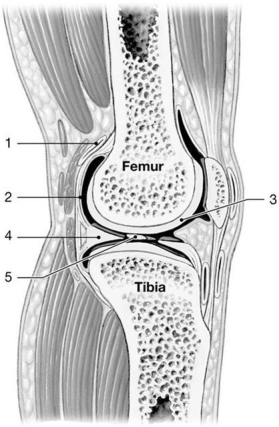A) rheumatism
B) degenerative joint disease
C) rheumatoid arthritis
D) osteoporosis
E) gouty arthritis
G) C) and D)
Correct Answer

verified
Correct Answer
verified
Multiple Choice
The movement of rotating a limb toward the anterior surface of the body is called ________ rotation.
A) frontal
B) external
C) lateral
D) outward
E) medial
G) C) and E)
Correct Answer

verified
Correct Answer
verified
Multiple Choice
A movement away from the midline of the body is called
A) inversion.
B) abduction.
C) adduction.
D) flexion.
E) extension.
G) A) and B)
Correct Answer

verified
Correct Answer
verified
Multiple Choice
The posterior longitudinal ligament is
A) a paired ligament that connects the laminae of adjacent vertebrae.
B) a fibrous band that connects the posterior surfaces of adjacent vertebral bodies.
C) a band of fibrous tissue connecting the spinous processes of adjacent vertebrae.
D) a longitudinal fibrous band that is attached to the tips of spinous processes from C7 to the sacrum.
E) a wide fibrous band that connect the anterior surfaces of the adjacent vertebral bodies.
G) A) and C)
Correct Answer

verified
Correct Answer
verified
Multiple Choice
The movement of a body part downward is called
A) retraction.
B) pronation.
C) depression.
D) protraction.
E) eversion.
G) A) and B)
Correct Answer

verified
Correct Answer
verified
Multiple Choice
Which of the following types of movement are not permitted at a synovial joint?
A) eversion
B) flexion
C) retraction
D) gliding
E) They are all permitted.
G) C) and E)
Correct Answer

verified
Correct Answer
verified
Multiple Choice
Figure 9-1 A Simplified Sectional View of the Knee Joint
 Use Figure 9-1 to answer the following questions:
-What type of tissue occurs at the structure labeled "3"?
Use Figure 9-1 to answer the following questions:
-What type of tissue occurs at the structure labeled "3"?
A) fibrocartilage
B) synovial membrane
C) articular cartilage
D) bone tissue
E) dense connective tissue
G) A) and C)
Correct Answer

verified
Correct Answer
verified
Multiple Choice
In-Text Figure Based Questions -What structure covers the bony surfaces of a synovial joint to prevent the surfaces from touching? (Figure 9-1)
A) fibrous joint capsule
B) synovial membrane
C) articular cartilage
D) elastic cartilage
E) meniscus
G) A) and B)
Correct Answer

verified
Correct Answer
verified
Multiple Choice
The coxal bones articulate with the sacrum at the ________ joint.
A) vertebrocoxal
B) coxosacral
C) iliocoxal
D) vertebroilial
E) sacroiliac
G) A) and D)
Correct Answer

verified
Correct Answer
verified
Multiple Choice
Figure 9-1 A Simplified Sectional View of the Knee Joint
 Use Figure 9-1 to answer the following questions:
-Which structure acts as a cushion and consists of fibrous cartilage?
Use Figure 9-1 to answer the following questions:
-Which structure acts as a cushion and consists of fibrous cartilage?
A) 1
B) 2
C) 3
D) 4
E) 5
G) B) and D)
Correct Answer

verified
Correct Answer
verified
Multiple Choice
________ subdivide synovial cavities, channel the flow of synovial fluid, and allow for variations in the shapes of the articular surfaces.
A) Fat pads
B) Menisci
C) Bursae
D) Lacunae
E) Fasciae
G) B) and C)
Correct Answer

verified
Correct Answer
verified
Multiple Choice
The most common athletic knee injury produces damage to the
A) patella.
B) lateral meniscus.
C) ligaments.
D) tendons.
E) medial meniscus.
G) C) and E)
Correct Answer

verified
Correct Answer
verified
Multiple Choice
Which type of joint is found between the carpal bones?
A) saddle
B) gliding
C) hinge
D) ball-and-socket
E) pivot
G) B) and D)
Correct Answer

verified
Correct Answer
verified
Multiple Choice
Dense fibrous connective tissue is to a suture as a periodontal ligament is to a(n)
A) amphiarthrosis.
B) syndesmosis.
C) synostosis.
D) synchondrosis.
E) gomphosis.
G) All of the above
Correct Answer

verified
Correct Answer
verified
Multiple Choice
The elbow joint is an example of a(n) ________ joint.
A) saddle
B) gliding
C) condylar
D) hinge
E) pivot
G) A) and C)
Correct Answer

verified
Correct Answer
verified
Multiple Choice
The ligament that encloses the ________ attaches to the tibial tuberosity.
A) head of the femur
B) greater trochanter
C) medial malleolus
D) lesser trochanter
E) patella
G) A) and D)
Correct Answer

verified
Correct Answer
verified
Multiple Choice
Which of the following is not a property of synovial joints?
A) freely movable
B) lined by a secretory epithelium
C) covered by a serous membrane
D) contain synovial fluid
E) covered by a capsule
G) C) and E)
Correct Answer

verified
Correct Answer
verified
Multiple Choice
The movements known as dorsiflexion and plantar flexion involve moving the
A) hand.
B) arm.
C) foot.
D) leg.
E) hip.
G) A) and D)
Correct Answer

verified
Correct Answer
verified
Multiple Choice
A general term for pain and stiffness that affects the skeletal or muscular system is
A) rheumatism.
B) atherosclerosis.
C) bursitis.
D) bunions.
E) arthritis.
G) None of the above
Correct Answer

verified
Correct Answer
verified
Multiple Choice
The movement of a body part upward is called
A) extension.
B) protraction.
C) supination.
D) elevation.
E) abduction.
G) A) and D)
Correct Answer

verified
Correct Answer
verified
Showing 101 - 120 of 134
Related Exams